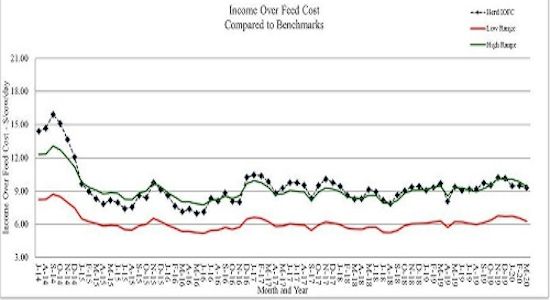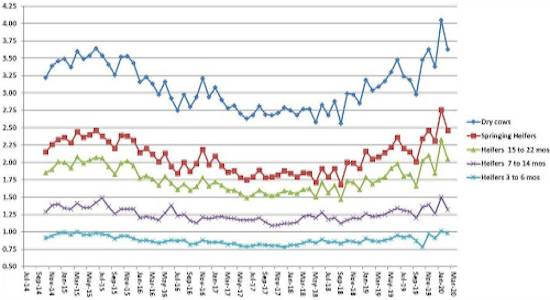By Virginia A. Ishler
Herds striving for high production and components realize both volume and components are the drivers for generating the most milk income.
Production perspective:
The release of the 2019 dairy statistics illustrates there are a lot of missed opportunities for the Pennsylvania dairy industry. The keystone state ranked number 6 for the most cows at 490,000 and number 7 for the most milk at 10,108 (millions of pounds). However, when it comes to milk pounds per cow, Pennsylvania does not make the top ten dairy states. The dairy operations in the states ranking higher than Pennsylvania such as New York and Wisconsin have a common production goal: generating 7 pounds of components. There are many herds achieving this goal and it requires both high milk volume and components. Based on several years of data compiled from the Extension Dairy Business Management team, achieving 5.5 to 6.0 pounds of components is challenging. What are the requirements for entry into the 7-pound club and why are producers setting this goal?
Achieving 7 pounds of components is a lofty objective but it is achievable as demonstrated by many herds across the country. Table 1 illustrates the pounds of milk required per cow coupled with the needed components. There is a misconception by some producers that averaging 60 to 65 pounds of milk with high components such as a 4.5% fat and 3.3% protein is the right strategy to optimize income. This is far from the truth. The pounds of components in that scenario result in around 5 pounds, which does not meet the minimum benchmark of greater than 5.5 pounds. The goal of 7 component pounds reflects an annual average, not just a few months out of the year. This goal is what provides the needed cash flow to sustain the dairy enterprise in today’s economy.
Herds striving for high production and components realize both volume and components are the drivers for generating the most milk income. Pounds of milk shipped is the platinum standard for achieving a positive cash flow plan. The high components provide the maximum milk price/cwt that can be received. Combining both volume and components provides the dairy operation the milk income needed to meet expenses for the operation. These results are achieved with excellent management practices and breeding programs that optimize volume and components.
Some key management areas to help move a herd to the 7-pound club are meeting benchmarks for forage quantity and quality, cow comfort, pregnancy rate, culling rate, and replacement animals. Maintaining the proper number of cows at high production to achieve the milk volume needed to cash flow is the first critical step. Managing heat abatement during the summer months to avoid drops in milk production and components is another critical element. There is no reason why Pennsylvania’s dairy industry cannot join the 7-pound club.
Table 1. Milk volume, milk fat and milk protein percent required to achieve 7 pounds of components
| Milk production pounds/cow | Milk fat percent | Milk protein percent | Component pounds |
|---|
| 100 | 4.2 | 3.1 | 7.3 |
| 100 | 4.1 | 3.1 | 7.2 |
| 100 | 4.0 | 3.1 | 7.1 |
| 100 | 3.9 | 3.1 | 7.0 |
| 100 | 4.0 | 3.2 | 7.2 |
| 100 | 3.9 | 3.2 | 7.1 |
| 100 | 3.8 | 3.2 | 7.0 |
| 95 | 4.2 | 3.2 | 7.0 |
| 95 | 4.1 | 3.3 | 7.0 |
Action plan for reaching 7 pounds of components
Goal - Increase pounds of components by one half pound above average from 2019.
Step 1: Using the monthly milk checks from 2019, enter in Excel the average milk pounds per cow and the percent fat and protein for each month for the year.
Step 2: Using Excel, calculate the pounds of components monthly and the annual average. Set a goal for one half pound higher than what was achieved in 2019.
Step 3: Evaluate the months with the lowest milk production and components. Develop a plan to minimize reductions during those times of the year.
Step 4: Monitor pounds of components monthly and include this as a metric for discussion groups or profit team meetings.
Step 5: Work with the appropriate consultants to implement strategies to meet goals for pounds of components.
Economic perspective:
Monitoring must include an economic component to determine if a management strategy is working or not. For the lactating cows, income over feed cost is a good way to check that feed costs are in line for the level of milk production. Starting with July 2014’s milk price, income over feed cost was calculated using average intake and production for the last six years from the Penn State dairy herd. The ration contained 63% forage consisting of corn silage, haylage and hay. The concentrate portion included corn grain, candy meal, sugar, canola meal, roasted soybeans, Optigen and a mineral vitamin mix. All market prices were used.
Also included are the feed costs for dry cows, springing heifers, pregnant heifers and growing heifers. The rations reflect what has been fed to these animal groups at the Penn State dairy herd. All market prices were used.
Income over feed cost using standardized rations and production data from the Penn State dairy herd.

Note: March’s Penn State milk price: $18.65/cwt; feed cost/cow: $6.38; average milk production: 84 lbs.
Feed cost/non-lactating animal/day.

Source : psu.edu